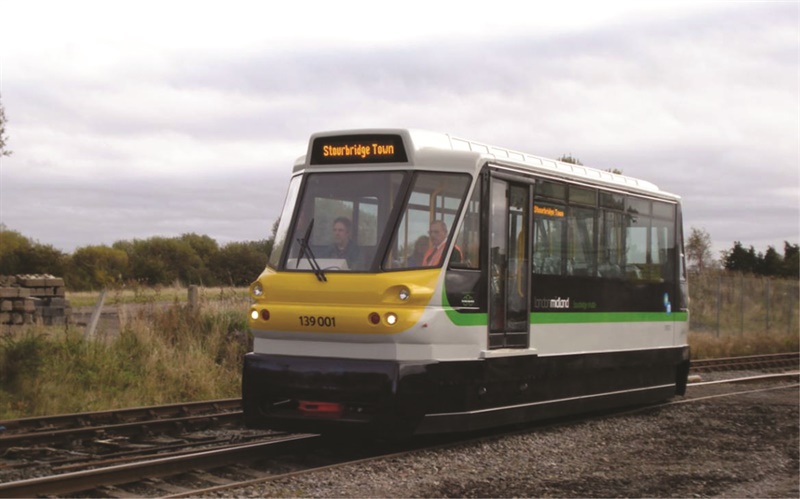01.05.14
The next steps for ultra-light rail
Source: Rail Technology Magazine Apr/May 2014
The Stourbridge Shuttle is a unique sight on the UK rail network, with 214 services a day delivered by two Parry People Movers. RTM caught up with its operator’s managing director, Philip Evans.
The 10-tonne Class 139 Parry People Movers (PPMs) that have been serving the Stourbridge Town branch line for nearly five years have eye-catching reliability statistics: 99.6% in the year to January 2014, and 100% for the first months of 2014.
They are a quarter of the weight of the Class 153 Sprinter that used to do the journey.
Passenger growth during 2013 compared to the previous year was an enviable 5.1%, with a ridership of more than 540,000 passengers on the three-minute link between Stourbridge Town and Junction stations, operated by Pre Metro Operations Ltd (PMOL) on behalf of London Midland.
The vehicles are famous for their flywheel energy storage system, which means energy is not wasted during decelerating and idling – instead it can be used for acceleration, allowing the engine to tick over at a constant rate and cutting emissions massively. It can therefore provide the energy required for the return journey on the 1 in 67 branch line incline to Stourbridge Junction station.
‘A very reliable service’
Philip Evans leads PMOL, a licensed TOC, alongside a board of directors. He was the former finance director at Centro, and has spent over 30 years in the public transport sector.
He told RTM: “Despite one or two hiccups at the very start, we’ve been providing a very reliable service to London Midland for the last five years. We’ve chugged along ‘in the background’, doing what we’re contracted to do: operating 214 trips a day, based in our little depot at Stourbridge, providing local people with a local service.”

The infrastructure is part of the main network, maintained by Network Rail, and London Midland meet any track access charges that arise. RTM asked Evans whether the light weight of the LPG-powered vehicles, and thus their reduced impact on the infrastructure, is reflected in lower track access charges.
He explained: “It is and it isn’t! We would expect that, and we certainly know that there’s less wear on the rails. But we are operating over a traditional railway branch line, which is short sections of bullhead rail.
“It does give a rough ride at times, because the maintenance that Network Rail provides is basically to maintain it as a Network Rail branch line, not a tramway. I know Network Rail will claim that they spend a fair amount of money maintaining the line, but in our position, we think that dealing with dropped joints between sections of rail, it’s much better than, say, replacing wooden sleepers like-for-like. The emphasis changes.”
Engineering support
The vehicles themselves, owned by Porterbrook Leading and provided to PMOL via London Midland, have “held up very well indeed”, he said, since their original manufacture by PPMs based in Cradley Heath in the West Midlands. “The vehicles have been tweaked once or twice; we’ve improved the performance over the years by improving the hydrostatic system, and one or two changes to the electronics and the settings.”
Engineering support used to come from JPM Parry and Associates, which was put into receivership in July 2013 following a winding-up order in the High Court. That company’s director, John Parry, the inventor behind the PPMs, is also a director at PMOL, which was unaffected by the financial problems at the other company.
Evans said: “We’ve employed our own engineers since that date. Everything’s in-house now, apart from one or two bits of specialist advice we may buy in from Linde Hydraulics or Power Torque Engineering etc. But the vehicles themselves have stood up to the service very well indeed.
“The intensity of the service, six round trips an hour, does put a strain on them. Most of the wear is when they stop, change ends and go back up the 1 in 67 incline to the Junction.”

Cutting traditional costs of operation
Evans added: “The advantages of this rolling stock arise from the low power consumption, and that derives from using LPG gas, which is environmentally friendly in the sense that its emissions are lower than diesel.
“Because of the flywheel technology, we’re saving on energy, and the vehicles themselves are less expensive than traditional rolling stock. There are a large number of derogations from RSSB on the vehicle itself.
“A lot of the savings come from the operational practice, because we’re operating as a tramway would hopefully operate on the network. We’ve got lower overheads, and we estimate that the cost of operation is only 50% of the previous service with a Class 153 unit.”
Timetable changes
The standalone nature of the service was evidenced earlier this year, when changes to the Snow Hill line timetable prompted complaints about missed connections at Stourbridge Junction.
Evans said: “We had a bit of a local outcry about missed connections – although, when you analyse the figures, an equal number of passengers gained as were disadvantaged by the change. One of our crew came up with a revised timetable, we talked it through with London Midland and they basically agreed with 99% of it. Because we’re a little standalone operation, we managed to get it implemented within a fortnight of it first being raised, which is unusual.”
Rob Hebron, chair of the Stourbridge Line User Group said: “We are delighted that London Midland has revised the timetable and commend the team behind this decision for being customer-focused and proactive.”
The future
Five years on, the question has to be – with PPMs so reliable, why aren’t we seeing more of them across the network?
Evans said: “We obviously believe that it’s adaptable for very many branch lines. We are talking to three or four different companies about the potential use of the technology and the method of operation at the next change of franchise. I can’t be more specific than that!”
Past suggestions for routes that could be served by the Class 139s – or a proposed larger variant – have included Helsby-Ellesmere Port, Stourbridge-Brierley Hill, non-electrified Great Western branch lines like Tamar Valley, and Pembroke Dock – Tenby. A proposal to use the vehicles on the Mid Hants Railway to Alton fell through.
Evans could not discuss the details on future routes being considered for PPM use, but did say: “One or two places are interested: if we can secure some work through the next franchise renewal process, all the better.
“There’s also the chance of re-opening a freight line for passenger service using this technology. There are a couple of prototypes knocking around, but the two at Stourbridge are the only two operating in the world.”
He welcomed the proposals for much larger bogie-mounted variants of the PPMs, which would mean more passenger capacity and a better ride quality. He added: “It’s an alternative to things like tram-train. Obviously there’s a lot of government money gone into tram-train, and we will learn from some of the experiences they’re gaining in South Yorkshire. But again, they’re relatively heavy vehicles.”
The Class 139/2 project to expand the PPMs has been supported by the Technology Strategy Board, which made a match-funded grant offer that has recently been transferred to Parry People Movers Ltd. John Parry said in a recent newsletter: “The intention is to complete a test bed railcar, work on which had already begun by JPM Parry & Associates Ltd prior to that company being put into receivership in July 2013.
“The R&D project is seen as vital to the future of PPM as it makes it possible to offer the larger 100+ passenger railcar, which will open many doors to the market.”
One unidentified TOC had included “a small fleet of Class 139 railcars” in its submission into the franchising process in 2012 – but
Parry implied that this was killed off by the West Coast debacle and the franchising upheaval that resulted.
(Image: Kevin Boyd)
Tell us what you think – have your say below or email [email protected]